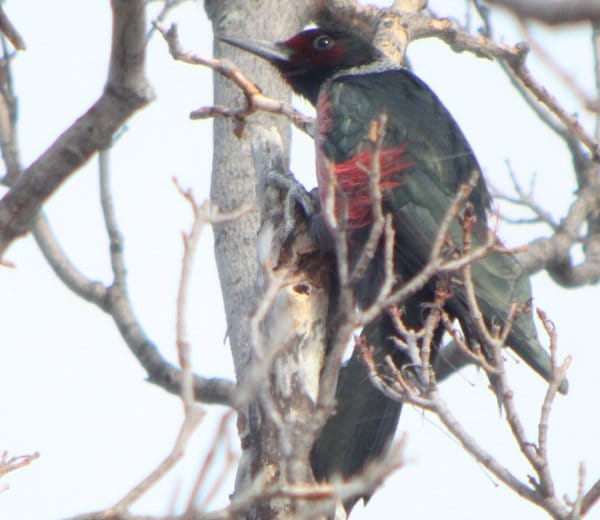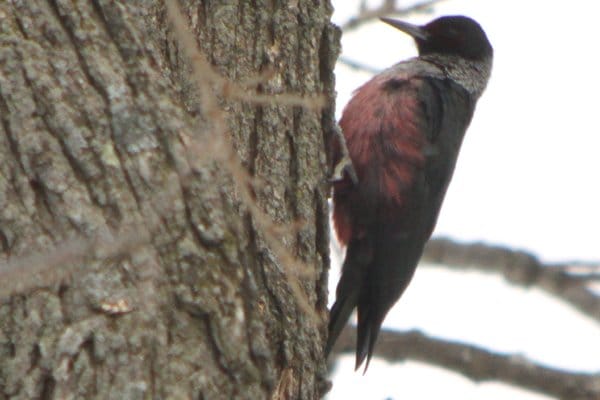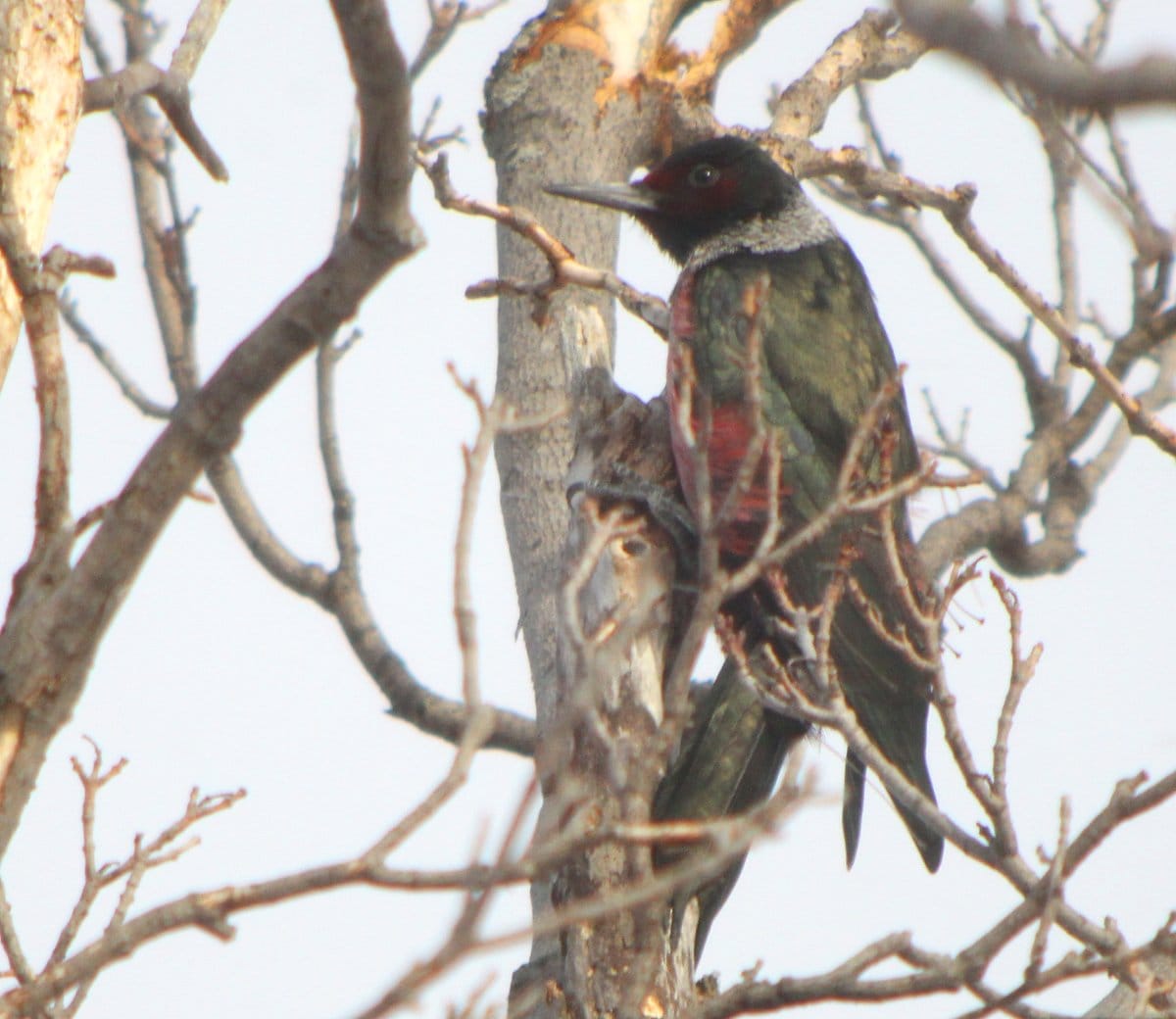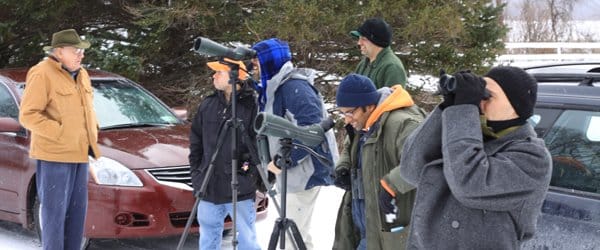Way back on 30 October of last year a Lewis’s Woodpecker was seen coming to a backyard bird feeder in Ontario  County, New York, and was quickly identified. Why is that awesome? Well, first of all, Lewis’s Woodpecker is one of the most amazing woodpeckers in North America, with a color scheme of pink, red, green and gray, or, as Julie Zickefoose once typed: “this creature looks and flies just like a crazy little crow, dressed up for Mardi Gras.” It is high on most birders’ lists of most-wanted birds in North America, at least those who have not yet seen one. Melanerpes lewis is, to put it simply, a really cool bird.
County, New York, and was quickly identified. Why is that awesome? Well, first of all, Lewis’s Woodpecker is one of the most amazing woodpeckers in North America, with a color scheme of pink, red, green and gray, or, as Julie Zickefoose once typed: “this creature looks and flies just like a crazy little crow, dressed up for Mardi Gras.” It is high on most birders’ lists of most-wanted birds in North America, at least those who have not yet seen one. Melanerpes lewis is, to put it simply, a really cool bird.
Second of all, Lewis’s Woodpeckers are birds of the west and they rarely stray to New York State. In fact, the bird is the fifth recorded in the history of the state,* and the first spotted in the Empire State since 2001.
Third of all, the bird that was first seen on 30 October is, as of this blog posting, STILL THERE! It made it through the rough winter and is still coming around to the feeders. The homeowner, Fred Jordan, has been hosting visiting birders who heard of the bird through word-of-mouth since November. He had put an embargo on the bird being reported to the internet for fear of a mob scene that would both alienate his neighbors and scare the bird off but because visiting birders have been so well-behaved he has had a change of heart. Or perhaps it is because over 200 birders have already visited, and that, coupled with the remote location that is Ontario County, means that there aren’t many birders left that are likely to chase the bird.**
What a bird!
But what does any of this have to do with 10,000 Birds? Well, way back in January, on the ninth to be exact, I loaded myself into a car with two intrepid Staten Islanders, Isaac and Tom, a fellow Queens birder, Andrew, and an Orange County birder and extraordinary wheelman, Gene, and made the long and arduous journey north and west to the promised land of Ontario County. And when I say “long and arduous journey” I mean over five hours through snowstorms, bad jokes, and growing anticipation of a great bird. Fortunately, Gene drove well. Really well. So well that we didn’t even have to slow down for snowstorms or traffic or anything because he just doesn’t flinch. It was a virtuoso performance by someone who should be making a living driving for NASCAR.
my life Lewis’s Woodpecker (click to make it bigger)
Of course because Mike (you know, the guy who started 10,000 Birds) lives in Rochester, which is a whole heck of a lot closer to Ontario County then New York City is, I had let him know about our long-range twitch and he agreed to not only meet us at Fred Jordan’s house but to make sure that he had the woodpecker in sight when we arrived. So you can imagine our disappointment when we crawled out of the car after our trip to find out that Mike was in fact relaxing in the warm kitchen and had no idea where the woodpecker was! Fortunately, Tom spotted it flying in and landing in a tree over the house and we all enjoyed scope views of a great bird, a lifer for most of us and Isaac’s 400th bird in New York State!
from left to right Fred, Mike, Isaac, Andrew, Gene (in back), Tom
Though it was an absurdly long trip and the ratio of birding to driving was not ideal the twitch was well worth it. I might never get to see a Lewis’s Woodpecker where they normally occur so the chance to see one within driving range of home was too good to pass up. Many thanks to Fred Jordan for being a wonderful host with great enthusiasm for his awesome avian visitor. Here’s hoping this bird makes it back to its home turf to breed and comes back to spend another winter in New York State!
…
*In 1954, from 27 October until 6 November there was one in Ossining, Westchester County, in 1997 there was one in Richfield Springs, Otsego County from 10 June until 21 June, and a second bird in Horicon, Warren County from 17 November until 29 November, and in 2001 there was one at Fort Drum from 1 May until 3 May.
**If you are interested in chasing the bird just look at the New York State birding listserv for info on how to contact Fred Jordan.
…
















This bird is too good even by your standards. I disapprove.
I agree. I should have closed my eyes so as not to have disturbed its beauty.
Oh wait, it’s not a Lewis’s Woodpecker. I have just analyzed the pictures more thoroughly. It is a Red-bellied Woodpecker that had fallen into a tank of chemical waste which bleached its nape and turned its feathers green with a bright red belly. It has now returned to seek revenge and wreak havoc in Ontario county before moving on to New York City.
Why so serious, Corey?
Mwahahahahaaaaar!
So glad I made the trip, what a bird! Hats off to Fred Jordan not only was he able to realize that this bird was a non resident but he really was a fantastic and gracious host.
It was a real thrill to see this bird, one I had missed out west. Yes, it was a very long trip, but what a beauty!!
I am glad Mr Jordan was pleased with the behavior of the birders whom he so graciously invited into his home. Apparently in the past some birders and photographers had been not so polite in their behavior when a Northern Hawk Owl had been in the vicinity, and when this bird showed up the local law enforcement did not want it made public. But after repeated good experiences with birders as individuals, Mr Jordan has consented to allow the bird to be made public before it leaves.
It truly is a beauty, and worth the very long trip.
Hi Everyone. I am new to this blog and I started reading it because I thought you were interested in the environment and conservation. I don’t understand why you are writing about how you all traveled a long ways, using gallons of gasoline, polluting our air, to see a bird. No matter how unusual or beautiful a bird is, isn’t our environment worth more? Isn’t conservation about putting the group ahead of the individual?
@Jochen: Mwahahahahahaha yourself! 🙂
@Tom and Jean: Agreed that it was a great experience, and, by the way, my explanation for Fred’s agreeing to have the bird posted on the state listserv is purely speculative (which I should have made clear in the post).
@Jacey: Having not owned a car for three years while commuting by subway makes me think that I can occasionally splurge on a long-distance trip. Also, packing five people into a sedan made our trip pretty efficient as automobile travel goes. And while your comment certainly has validity and I wouldn’t recommend taking such trips regularly, the fact is that an occasional car trip to see a good bird is not going to make a difference compared to, say, the millions who commute back and forth in a car every single day.
Also, your using a computer burns carbon. Shouldn’t you be reading a book instead?
@Jacey: you are generally right, this is the ideal which everyone should follow. However, hardly anyone is following these ideals. That is the harsh reality.
Nature conservation is always a struggle “against the current”, a minority trying to convince a generally naive or indifferent, sometimes even hostile majority of its ideals and ideas.
This process is extremely frustrating over time, as I can attest having worked hard for nature conservation for well over 30 years now. The people who are concerned about nature conservation therefore simply need a little “motivation boost” once in a while, they need the feeling of not being alone in their struggle but being part of a large (and growing) community with a common interest.
I think that people concerned about the environment ought to be very careful about one thing: this is the “information age” in a “globalized” environment – business will act globally, interact with each other, form international alliances etc., and business people won’t give a flying fly about carbon footprint and the fuel they burn. They will travel from New York to Tokyo simply for a single meeting lasting an hour. During my days in Namibia, I witnessed groups of Japanese flying from Japan to southern Africa on Friday, playing golf there on Saturday and flying back to Japan on Sunday because that was less expensive than playing a whole day on a Japanese golf course.
This crazyness is happening, and it is happening a million times each hour.
People concerned about nature conservation won’t stop this madness by staying at home, each and everyone isolated in their little neighbourhood. They need to connect just the same, which will mean burn some fuel.
Of course the value of Corey’s trip to see a woodpecker for nature conservation is debatable. However, he enjoyed it and it filled up his battery. He did his best to reduce fuel emissions. He connected with others and they surely chatted about other things as well, not just the woodpecker – possibly nature conservation. They got re-motivated or their motivation was increased. And he blogged about it, so quite a few people will read his tale and say to themselves that they really should go birding more, and pay more attention to the birds around them. and when they do go outside, they might write down what they see and enter it into eBird (as Corey does), adding to the scientific data base that’s used for …. nature conservation.
Oh, and I haven’t even started to talk about eco tourism. If birders didn’t travel to – say – South America, those private lodges and reserves who now protect their parrots and macaws for birding tourists would have no economic choice but to catch them again in an unsustainable way, as they have sometimes done before, and sell them to the pet trade, which will mostly go to … tatatataaaaa: the USA.
To conclude: while your comment generally points in the right direction and shows us what ideals we ought to follow, it seems to not take the realities of this world into account enough. And this might lead to more trouble for nature conservation and the environment in the end.
@Jochen: That was a much more politic response…thanks!
@Corey: please don’t take this as criticism, but I felt Jacey’s comment was well-founded and well-phrased enough to merit a more elaborate response. As you know, I now work for a very large global company as an ecological consultant/manager, and you won’t believe the amount of travel our engineers have to go through just to keep the business running (most would rather stay with their families most of the time). Of course I feel bad if I have to travel all across Europe, sometimes for just one short meeting lasting an hour. But if this meeting means that 100 ha of valuable habitats will be saved from senseless development, than that’s fine with me and worth the fuel…